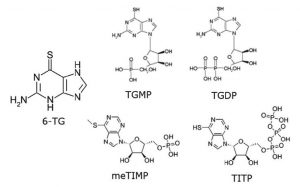Separation using LCMS Gradient Method
The Cogent Diamond Hydride Column with gradient elution was used for analysis of Thiopurines. Figure A shows the Peak of 6-TG, which also can be analyzed using Isocratic conditions. Good retention and symmetrical peak shape were obtained under the analysis conditions.
Figure B represents two separated Thiopurines (Mono and Di- Phosphate forms). Figure C shows two Inosine compounds, one with an additional Methyl group, being separated.


Peaks:
A: Thioguanine (6-TG) at m/z = 168.0338 [M+H]+
B: 6-Thioguanosine -5´-Phosphate (TGMP) at m/z =380.3, 6-Thioguanosine -5´-Diphosphate (TGDP) at m/z= 460.3
C: 6-Methyl-Thioinosine-5´-Monophosphate (meTIMP) at m/z = 379.3 and 6-Thioinosine-5´-Triphosphate (TITP) at m/z = 525
Method Conditions
Column: Cogent Diamond Hydride™, 4μm, 100Å
Catalog No.: 70000-15P-2
Dimensions: 2.1 x 150mm
Mobile Phase:
—A: DI Water / 50% Methanol / 0.1% Formic Acid (v/v)
—B: Acetonitrile / 0.1% Formic Acid (v/v)
Gradient:
| Time (minutes) | %B |
| 0 | 100 |
| 12 | 30 |
| 14 | 30 |
| 15 | 0 |
| 19 | 0 |
| 20 | 100 |
Post Time: 2 minutes
Flow rate: 0.4 mL/minute
Detection: ESI – POS – Agilent 6210 MSD TOF Mass Spectrometer
Injection vol.: 1μL
Sample Preparation: 0.4 mg/mL solutions in DI Water. For MS analysis, samples were diluted 1:100 into 50% Acetonitrile / 50% DI Water mixture. Before injection, samples were filtered through a 0.45µm Nylon Syringe Filter (MicroSolv Tech Corp.).
Attachment
No 322 Analysis of Thiopurines pdf 0.3 Mb Download File


